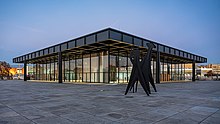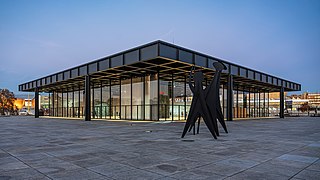
The Neue Nationalgalerie at the Kulturforum is a museum for modern art in Berlin, with its main focus on the 20th century. It is part of the National Gallery of the Berlin State Museums. The museum building and its sculpture gardens were designed by Ludwig Mies van der Rohe and opened on September 15th, 1968.

Adolph Friedrich Erdmann von Menzel was a German Realist artist noted for drawings, etchings, and paintings. Along with Caspar David Friedrich, he is considered one of the two most prominent German painters of the 19th century, and was the most successful artist of his era in Germany. First known as Adolph Menzel, he was knighted in 1898 and changed his name to Adolph von Menzel.

The Altes Museum is a listed building on the Museum Island in the historic centre of Berlin, Germany. Built between 1825 and 1830 by order of King Frederick William III of Prussia according to plans by Karl Friedrich Schinkel, it is considered a major work of German Neoclassical architecture. It is surrounded by the Berlin Cathedral to the east, the Berlin Palace to the south and the Zeughaus to the west. Currently, the Altes Museum houses the Antikensammlung and parts of the Münzkabinett. As part of the Museum Island complex, the Altes Museum was listed as a UNESCO World Heritage Site in 1999, in recognition of its testimony to the development of the museum as a social and architectural phenomenon.
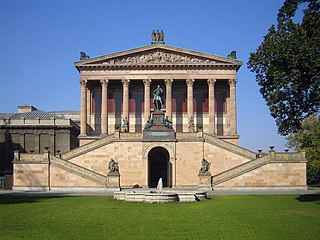
The Alte Nationalgalerie is a listed building on the Museum Island in the historic centre of Berlin, Germany. The gallery was built from 1862 to 1876 by the order of King Frederick William IV of Prussia according to plans by Friedrich August Stüler and Johann Heinrich Strack in Neoclassical and Renaissance Revival styles. The building's outside stair features a memorial to Frederick William IV. Currently, the Alte Nationalgalerie is home to paintings and sculptures of the 19th century and hosts a variety of tourist buses daily. As part of the Museum Island complex, the gallery was inscribed on the UNESCO World Heritage List in 1999 for its outstanding architecture and its testimony to the development of museums and galleries as a cultural phenomenon in the late 19th century.
The Prussian Cultural Heritage Foundation is a German federal government body that oversees 27 museums and cultural organizations in and around Berlin, Germany. Its purview includes all of Berlin's State Museums, the Berlin State Library, the Prussian Privy State Archives and a variety of institutes and research centers. As such, it is one of the largest cultural organizations in the world, and also the largest cultural employer in Germany with around 2,000 staff as of 2020. More than four million people visited its museums in 2019.

The Staatliche Museen zu Berlin are a group of institutions in Berlin, Germany, comprising seventeen museums in five clusters; several research institutes; libraries; and supporting facilities. They are overseen by the Prussian Cultural Heritage Foundation and funded by the German federal government in collaboration with Germany's federal states. The central complex on Museum Island was added to the UNESCO list of World Heritage Sites in 1999. By 2007, the Staatliche Museen zu Berlin had grown into the largest complex of museums in Europe. The museum was originally founded by King Friedrich Wilhelm III of Prussia in 1823 as the Königliche Museen.

Friedrichswerder Church was the first Neo-Gothic church built in Berlin, Germany. It was designed by an architect better known for his Neoclassical architecture, Karl Friedrich Schinkel, and was built under his direction from 1824 to 1831.
The Antikensammlung Berlin is one of the most important collections of classical art in the world, now held in the Altes Museum and Pergamon Museum in Berlin, Germany. It contains thousands of ancient archaeological artefacts from the ancient Greek, Roman, Etruscan and Cypriot civilizations. Its main attraction is the Pergamon Altar and Greek and Roman architectural elements from Priene, Magnesia, Baalbek and Falerii. In addition, the collection includes a large number of ancient sculptures, vases, terracottas, bronzes, sarcophagi, engraved gems and metalwork.

Klaus Biesenbach is a German-American curator and museum director. He is the Director of the Neue Nationalgalerie, with Berggruen Museum and Scharf-Gerstenberg Collection, as well as the berlin modern under construction.

The Scharf-Gerstenberg Collection is an art museum in Berlin. Its collection of paintings, graphics and sculptures, spanning the period from French Romanticism to Surrealism, is currently housed in former rooms of the Egyptian Museum in Charlottenburg on a ten-year loan. It was founded in 2008, and is part of the National Gallery of Berlin.

The Kunstgewerbemuseum, or Museum of Decorative Arts, is an internationally important museum of the decorative arts in Berlin, Germany, part of the Staatliche Museen zu Berlin. The collection is split between the Kunstgewerbemuseum building at the Kulturforum (52°30′35″N13°22′03″E) and Köpenick Palace (52°26′38″N13°34′22″E).
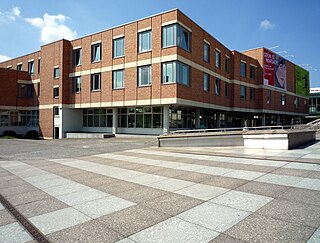
The Kupferstichkabinett, or Museum of Prints and Drawings, is a prints museum in Berlin, Germany. It is part of the Berlin State Museums, and is located in the Kulturforum on Potsdamer Platz. It is the largest museum of graphic art in Germany, with more than 500,000 prints and around 110,000 individual works on paper.

Joachim Heinrich Wilhelm Wagener was a German banker and patron of the arts. His collection formed the initial nucleus of the Alte Nationalgalerie in Berlin.

The Kronprinzenpalais is a former Royal Prussian residence on Unter den Linden boulevard in the historic centre of Berlin. It was built in 1663 and renovated in 1857 according to plans by Heinrich Strack in Neoclassical style. From 1919 to 1937, it was home to the modern art collection of the National Gallery. Damaged during the Allied bombing in World War II, the Kronprinzenpalais was rebuilt from 1968 to 1970 by Richard Paulick as part of the Forum Fridericianum. In 1990, the German Reunification Treaty was signed in the listed building. Since then, it has been used for events and exhibitions.

The Museum of Islamic Art is located in the Pergamon Museum and is part of the Staatliche Museen zu Berlin.

The statuette of hoplite found at Dodona is an archaeological find which was purchased in 1880 and is hosted today in Berlin at the Altes Museum
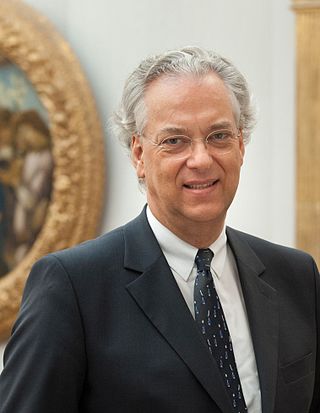
Michael Eissenhauer is a German art historian and was director-general of the Staatliche Museen zu Berlin.

Alexis Akrithakis was a Greek contemporary artist renowned for his paintings and wooden constructions. His works have been described as "speaking an unmistakable language. They stand on their own and are original, but are yet influenced by the particular Zeitgeist - between Arte Povera and Actioninsm".
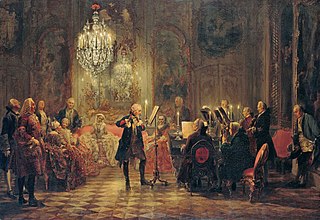
Frederick the Great Playing the Flute at Sanssouci or The Flute Concert is an 1852 oil on canvas history painting by the German painter Adolph Menzel. It depicts Frederick the Great, King of Prussia playing the flute at an evening concert at Sanssouci and is now in the Alte Nationalgalerie in Berlin.

The Balcony Room is an oil-on-canvas painting by the German artist Adolph Menzel, executed in 1845. It is one of the main works of his early period and one of his most famous paintings. It has belonged to the collection of the Alte Nationalgalerie in Berlin, since 1903.


